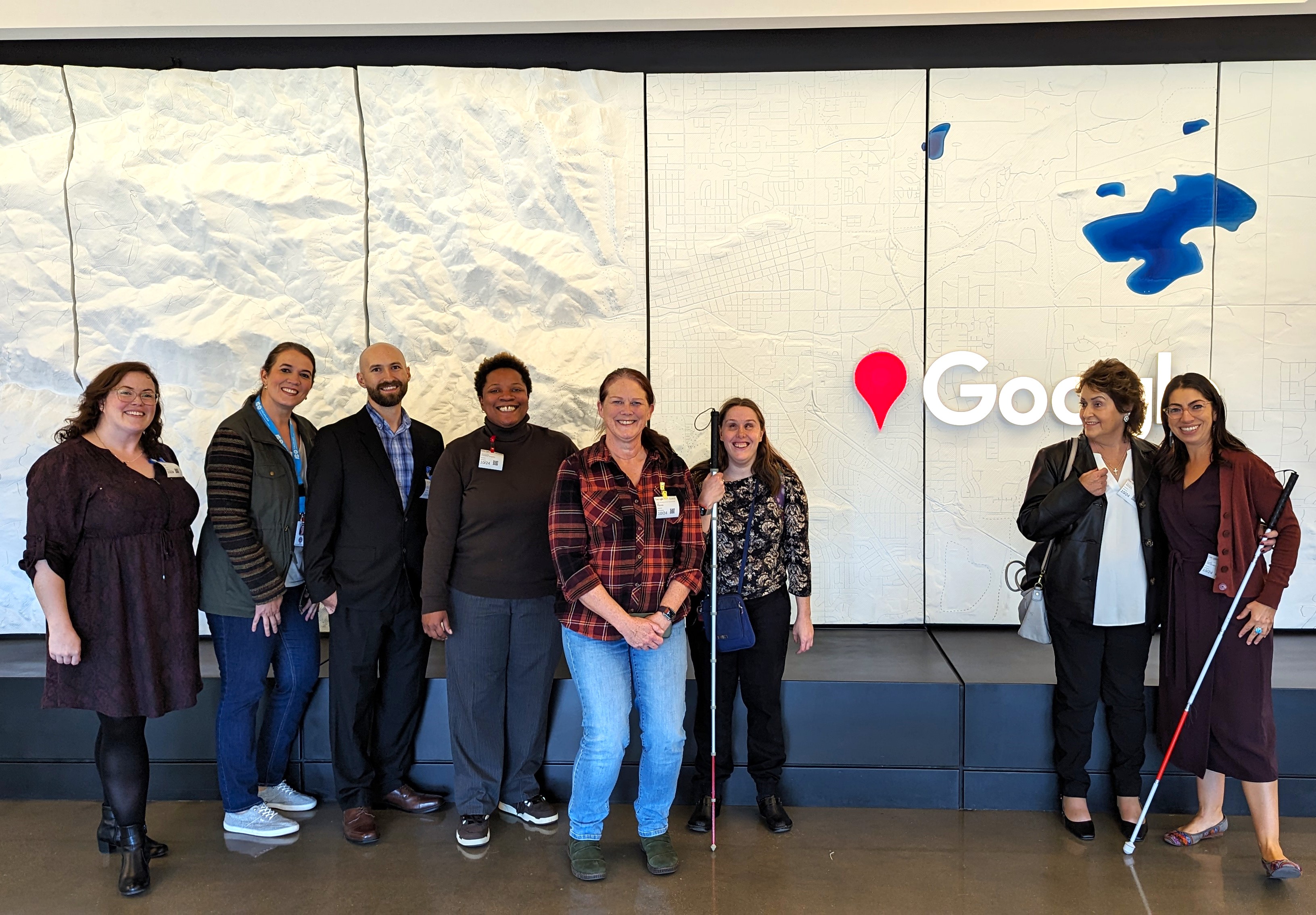State of Colorado Accessibility Newsletter - November 2023

Accessibility News
TAP launches Empathy Lab, Community Steering Committee
In an ever-changing and expanding remote and digital world, services and resources need to be available online, without barriers. Unfortunately, that is not always the case for people with disabilities. On Nov. 2, OIT’s Technology Accessibility Program (TAP) team launched the Empathy Lab, a virtual inclusion and awareness lab designed to expand awareness and a desire to create accessible and equitable digital products.
The virtual launch event featured remarks by OIT’s Chief Information Officer & Executive Director Anthony Neal-Graves, Colorado House Representative David Ortiz, and a recorded video message by Governor Jared Polis. TAP’s Kate Miller also introduced the new 10-member Community Steering Committee (CSC), a group of diverse Coloradans who will provide insight and guidance on the lived experiences various communities are having with digital services.
The Empathy Lab features an experiential and demonstrative learning site, inviting users to interact with 19 exercises that show, rather than tell, the power of accessibility. Users can:
- View images through different lenses to experience color vision impairment
- Discover how words matter to different audiences and how plain language can impact people with dyslexia or cognitive disabilities
- See how forms, documents and webpages can be experienced in different ways
The goal is to help users understand the barriers faced by people with disabilities and what tools are available. (Please note, for now the site is only available to employees in state agencies receiving IT support and services from OIT)
This new and innovative resource is a chance for state employees to sharpen and hone our accessibility skills for the products we work with by demonstrating everyday accessibility barriers and offering a glimpse into how people with disabilities work with assistive technology.

Accessibility Tips - November is Procurement Month
Accessible Procurement Toolkit for the State
By Karen Pellegrin, Senior TAP Manager
(Please note, the Toolkit may contain content exclusively for state agencies receiving IT support and services from OIT. All content within the Toolkit is available to be repurposed by other state agencies and local governments.)
Purchasing digital products and services that are accessible is critically important in ensuring that new technology has the least amount of issues as possible. This can save your organization a significant amount of time, money and resources by reducing efforts to fix or have issues fixed at a cost after purchase.
With this in mind, the TAP team has developed an Accessibility Procurement Toolkit that is designed to assist your organization in procuring accessible vendor products and development services. The toolkit provides a number of resources and guidance to help ensure you are procuring the most accessible products possible now and in the future.
Within the toolkit is a Standard Operating Procedure for Procuring Accessible IT which outlines steps to address accessibility compliance in your procurement efforts along with other tools and guidance for products you have already procured including:
- Strategies for Procuring Accessible IT presentation which gives additional guidance on accessibility procurement methods
- Guidance on Accessibility Risk Assessments and how to request them from OIT (for State Executive Branch agencies) or perform them yourself
- How to Use an Accessibility Compliance Report and identifying warning signs
- Understanding an Accessibility Compliance Report presentation which gives a breakdown on how to read and understand the information provided
- Vendor Letter Template to send to your existing vendors letting them know of their compliance requirements
- Common definitions related to accessibility and procurement
We hope these tools assist you in procuring the most accessible technology solutions for your organization and we are currently partnering with the State Purchasing and Contracts Office to collaborate and share these resources with our procurement professionals, vendors and customers on their State Purchasing and Contracts website and in other communications.
OIT’s New Solution Evaluations for Assessing Accessibility Risk
By Cierra Perreira, OIT Principal Solutions Engineer
(Please note, this service is only available to employees in state agencies receiving IT support and services from OIT)
Recent legislation has driven the OIT Solution Engineering team to design and implement a new service called Solution Evaluations. Solution Evaluations are designed to provide risk assessments on inbound IT purchase requests from all agencies. The evaluations include high level risk assessments on software, hardware, and solicitations. With each evaluation request, accessibility, security, and contracting will be reviewed and scored based on models developed by OIT teams.
Conducting accessibility risk assessments is crucial for OIT and agencies because it allows for more guidance with inclusivity as well as compliance with accessibility standards. Identifying potential barriers and addressing them proactively helps create products and services that can be used by individuals with disabilities, broadening the reach of the solution and avoiding legal and reputational risks.
OIT has already begun performing these evaluations on a number of products and encourages our State Executive Branch agencies to bring their products to OIT for these evaluations. Requests can be made through the customer portal under "other" software request. Let us do the work for you and give you more confidence in your technology purchases.
Accessibility & You
Diving Into Accessibility in IT Procurement
By Jeff Kline, Strategic Accessibility Consultant and Author
For almost any size public or private sector organization, most of the IT deployed for external or internal use is procured from third parties. With such a dependency on procured IT, addressing accessibility must be a high priority when selecting IT offerings and awarding contracts.
Understanding the level of accessibility of procured products and services for compliance to OIT’s Technical Standards can be challenging, as products and services offered do not have credible or accurate accessibility documentation. This problem can result in uninformed or naive decision making that leads to:
- Barriers to access in the use of procured products and services
- Disenfranchising and denying opportunities to people with disabilities
- Potential legal actions for discrimination
Prevention of these outcomes is possible with proper training of staff on accessibility in IT procurement, proper guidance and support documentation, and having accessibility requirements baked into the procurement life cycle. With these tools under an agency’s belt, it can more confidently:
- Ensure they are making the best decisions possible for procuring accessible IT products and services
- Establish an understanding of accessibility shortcomings (noncompliance) in the selection and award process (hint: most products are not fully compliant to accessibility standards)
- Mitigate the risks associated with randomly procuring inaccessible products and services
It is important to recognize that there are significant differences in documentation (or lack thereof!) between the procurement of Commercial Off The Shelf (COTS) IT and the procurement of development services for custom websites and applications, or hybrid (COTS + dev services) procurements.
- Accessibility levels for COTS offerings should be documented and available from product manufacturers in Accessibility Conformance Reports (ACRs) created from one of several standard versions of the ITIA Voluntary Product Accessibility Template 2.3 or higher. But be warned! Many ACRs contain inaccurate information due to the absence of manufacturer knowledge or product accessibility testing used to properly complete them.
In my book, Strategic IT Accessibility: Enabling the Organization, I discuss this problem in detail. I have developed a list of many (but not all) ACR red flag issues that I have discovered through my analysis of thousands of ACRs during my tenure as Program Director of IT Accessibility for the Texas state government.
Once ACRs are analyzed in the initial phases of procurement, additional information may be needed from vendors to gain confidence in the validity (or lack thereof) of what was provided in their ACRs.
- Procuring IT development services is a different matter. ACRs will not exist because the deliverables do not yet exist; therefore, other forms of “credible evidence” need to be obtained from the vendor to ensure that these candidate vendors understand and can produce accessibility compliant IT deliverables.
For this type of IT procurement, to buy or not buy services from a vendor based on your analysis should be binary. When the right questions are asked and trained personnel are analyzing the responses, it will become quickly obvious whether or not the vendor possesses the ability and experience to provide accessible deliverables. Questions should include inquiries around development processes, development and testing tools and techniques, and very importantly —prior work examples.
Then, in the contract language for such services, be sure to integrate accessibility checkpoint criteria into the main phases of the development effort to ensure that the accessibility requirements are being completed in every phase, to avoid the pain and suffering of dealing with contractual and functional (compliance) issues at the time the IT is ready to launch.
I hope that this overview has provided some useful knowledge and perspective about key aspects of procuring accessible IT and its importance.
Accessibility Essentials
How to Write Great Alt Text
By Kelly Tabor, TAP Communications Manager
Part of creating an equitable and inclusive digital world means offering alternatives to auditory and visual content. Also called alt tags and alt descriptions, alt text is written copy that acts as a replacement for an image to help people using assistive tech like screen readers to absorb the content on a webpage. Alt text also benefits people who have poor or unstable internet where the image fails to load on a user's screen. Additionally, alt text can act as keywords, allowing search engines to better crawl and rank websites. Here are some tips for writing fabulous alt text:
- Keep it short and descriptive, like a tweet or a caption, but avoid using single words. Try to limit alt text to fewer than 125 characters. Think about how you would briefly describe the image over the phone.
- Avoid making assumptions about ethnicity, gender, what's happening outside of the snapshot, or the subject's thoughts, emotions or motivations.
- Don't include “image of” or “photo of” in your description.
- Be sure to use “people first” language in your descriptions. For example, “A young woman with low vision or blindness sits on a red bench and holds a mobile device.”
- Do not include alt text for all images. Add alt text to all non-decorative images but leave alt text blank if the image is purely decorative.
More resources:
The WC3 Alt Text Decision Tree
WebAIM’s Helpful Techniques for Alt Text

A Group Pic at Google
The TAP and EDI crews got a tour of the Google campus in Boulder in October! As part of OIT’s partnership with Google, the teams chatted about their experiences regarding accessibility of Google products, future collaborations, how to address accessibility issues, and looked at upcoming accessibility features. The day was spent exploring the diverse workspaces and amenities at the campus including a coffee bar, bike shop, yoga studio, music rooms, gym and climbing wall.
(Left to right: Beckie Bean, Kelly Tabor, Mason Greene, Timniyha Owens-Staples, Liz Haynes, Chelsea Cook, Theresa Montano, and Sarah Consuelo Hernandez)
Notable & Quotable
“The one argument for accessibility that doesn’t get made nearly often enough is how extraordinarily better it makes some people’s lives. How many opportunities do we have to dramatically improve people’s lives just by doing our job a little better?”
- Steve Krug, Usability/UX consultant and the author of Don't Make Me Think and Rocket Surgery Made Easy

